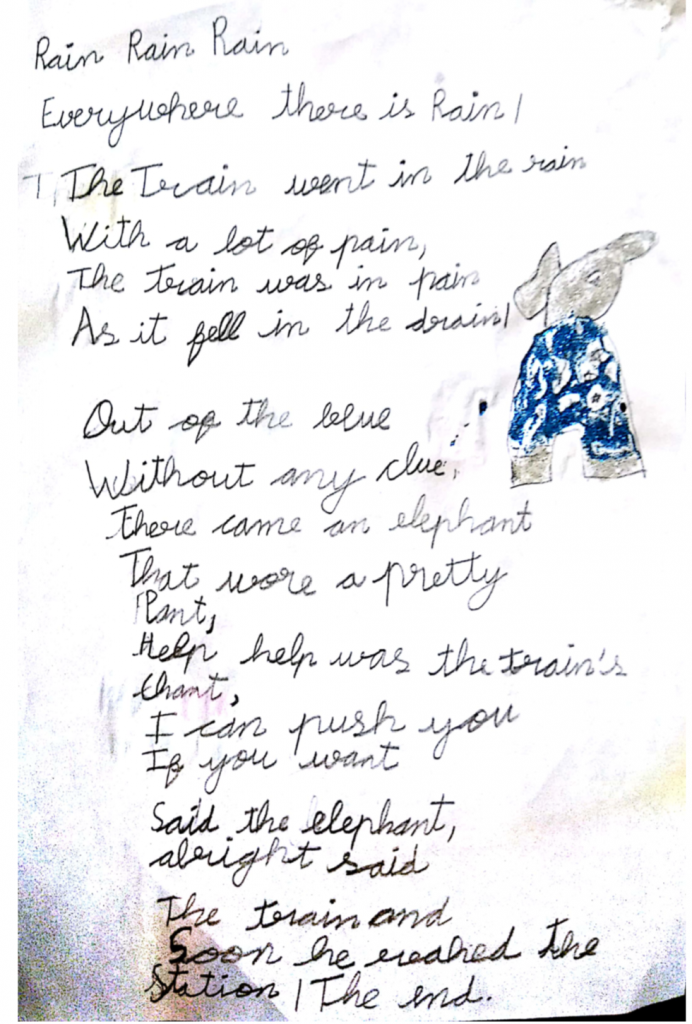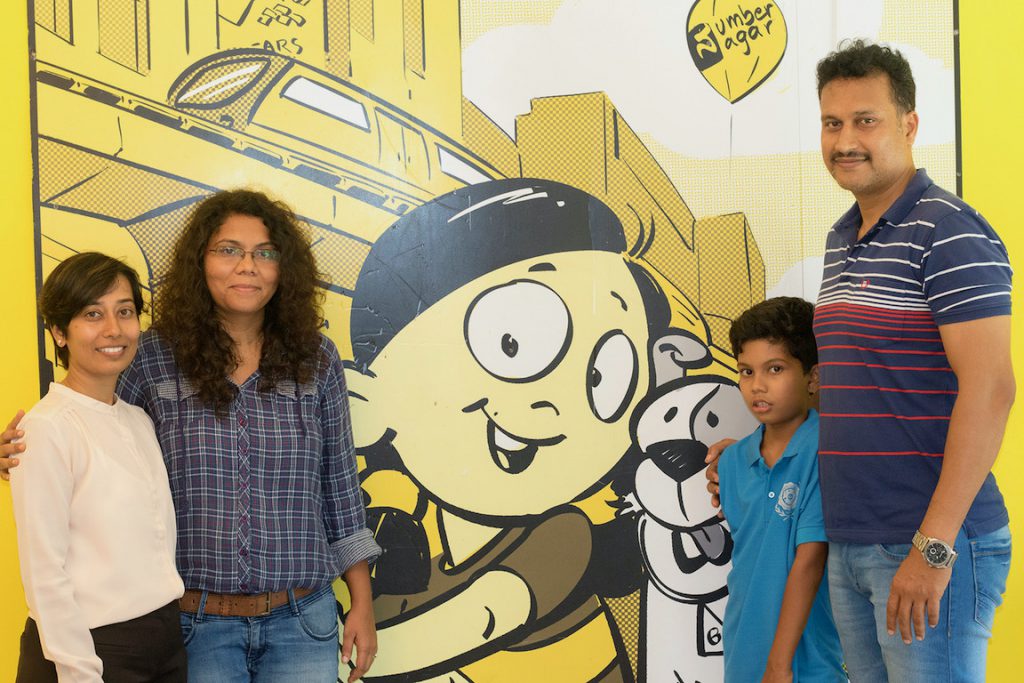Learning is not an activity; it is a process. We can connect the dots only looking backward, not forward. When children are allowed the opportunity to exercise their imagination and creativity, their learning truly has no limits.
At NumberNagar®, we strive to create these opportunities for children. We share below one such happy story of a child’s learning journey. It started as a simple summer assignment and took on wings that no one could have imagined. It fills our hearts with joy to share this story.
In the words of Suma, Arnav’s mother:
One summer day morning, Arnav came up to me and told me that he had an English assignment – to write a poem. I started to think, how do I keep my 9-year-old occupied for 60 days with just one poem? Obviously, he is not going to be interested in perfecting his poem. He wouldn’t spend more than half an hour thinking about what he wants to write about. Most probably, he will finish up writing in a maximum of 15 minutes.
The problem statement:
- I have a 9-year-old with lots of curiosity to learn.
- When I say learn, mind you – only new things! He is not interested in any kind of deep learning or gaining mastery over the subject like we adults are.
- He has 60 days of holiday lined up which he is super excited about, not bothered about summer assignments
This puts me in a tricky situation. I need to find ways to make him complete his assignment and keep him occupied for the entire holiday period. I also need to ensure that the whole journey is super exciting for both of us. There is no way he is going to do anything less than exciting during his holidays!
The germ of an idea:
It was a Saturday morning, as usual I dropped him to English class at NumberNagar®. Aruna ma’am and Arnav started their work on the poem.
Meanwhile, I had an hour to devise the whole plan for this assignment. A cup of hot coffee and I decided to take on this challenge. I stared at the one-line assignment – “Write a poem in English” – as I sipped my hot coffee. After a while, my face lit up with a chain of thoughts and that was my Eureka moment!
Deep in these thoughts, I did not even realise that I was late to pick him up from class. When I reached NumberNagar®, to my surprise, the poem was ready. I must say they had done a fantastic job! On the way back home, I shared with Arnav my brainwave of getting his poem printed. He got super excited and said, “Yes Amma, let’s do it!”
The implementation:
It was my turn now to work on adding illustrations to the poem and make it colourful and attractive. I finished this at night and delightfully showed him the work in the morning. As usual, Mr. Critic had some suggestions and corrections. 😊 I fixed up the illustrations to meet his expectations.
Next, we started our search for a place to get it printed and ended up in a small printing press. We negotiated the price with him and finally decided to get 100 copies printed. We went there for 10 copies but got 100 copies. Not sure who negotiated with whom! 😊


The subsequent strategy:
Although we were excited, there was a new problem in front of us. What do we do with 100 copies! Now I have the finished product with me and the author who is all excited to show off his work.
The next thought was – “Let’s sell it!” This converted our English poem writing task to “Sales and Marketing 101”. The following week, we had a family gathering at Arnav’s grandfather’s house for the housewarming ceremony. We thought this occasion would be the best opportunity to sell.
The field experience:
On the day of housewarming, our little boy was all suited up with a bag full of his books; totally unaware of what is sales or marketing. The activity started off casually, people appreciated Arnav for his poem and he sold his first 10 books within half an hour. He was all excited and probably dreaming that the rest of his day would be similar.
As the day progressed, he started facing challenges one after the other.
Initially, it was that people did not have the change to pay him. So, he had to count money in his pocket to give out the exact change. His Maths skills were put to test. The speed of his calculation had to be high, otherwise, potential customers were passing by and he was losing them.
The next challenge was that people were very appreciative of his work but not ready to pay for the book. He built up a strategy to negotiate. Perhaps the negotiation at the printing shop was his inspiration. He thought negotiation would solve the problem. On the contrary, people were negotiating hard with him. The same book he sold in 5 minutes earlier was taking 10 minutes or more and with lesser profit.
Meanwhile, his potential easy customer base was becoming smaller and smaller.
Pushed by these challenges, he devised another strategy. His campaign was – “Free book if you flip the water bottle and make it stand upside down in 3 chances. Otherwise, pay!” With this, people got interested to buy the book. Like with children, the excitement of the game lured them into it. Unknowingly, he had widened his target customer base. He had also diverted customer focus towards the game. They were no more negotiating about the price because the best offer of free product was already on the table.
The reflection:
He really surprised me that day. I was observing the little one from far and started to think, do we really need to teach our kids anything? They have most of the required qualities inherent within them. They come with tremendous focus and adaptability. They are who they are and ready to take on the world. All we must do is give them opportunities to discover themselves.
Do you think education is limited to grades received on assignment papers? Is it fair to judge a child’s overall ability by those grades? Should we only focus on improving those grades?
The aftermath:
By the way, he sold 65 out of 100 books that day. 😊
Later, he was requested for 30 copies of the book by NumberNagar®. NumberNagar® will pay him by cheque. The journey will continue for him to understand how banks work.
On the other hand, he has earned money and understands profit. Now he has come to me asking, “Amma what do we do with my money? I want to buy toys but do not want to spend all the money!” Time for him to explore aspects of investment and not forget contributing to society. “Cauvery Calling Campaign” is our choice, so you will know by now where his learning journey will continue.
Do you think the journey of “Write a poem in English” has reached an end?
In the words of Arnav:
The same story is narrated by Arnav from his point of view. Do check the audio to hear his perspective.
Also, check out the following video created out of this experience.
Parting words:
There is so much we can learn from children if only we have the will to do so. Let us allow ourselves to learn from them. We would love to hear your stories about how you learn from children.
Special thanks to Suma, Arnav’s mother, who wrote this article. Also, special thanks to Arnav who narrated his story.
Latest posts by Team NumberNagar® (see all)
- What is the most valuable gift you have given your child? - 18 September 2020
- What’s in a name? - 15 May 2020
- The Anatomy of a Summer Assignment - 18 October 2019
- The Pressing Need for Child-Centric Learning - 1 March 2019
- Secrets to Prosperity - 18 February 2018


Wonderful. Great going.
Thank you, Vani. Stay tuned for more stories.
Wonderful
Thank you, Raghu! These experiences are what we live for, wishing you the same. All the best!
Wonderful, a big applause to Arnav and it was nicely enlightened by you Suma!
Thank you, Bharath! Indeed, Arnav and Suma both need a huge applause.
Amazing Suma.. love your parenting skills
Thank you, Deepthi! Surely, kudos to Suma!
Amazing article!!! Got some ideas on how to build the out of book skills in our children…. Nice work Suma !
Thank you, Supriya! So glad you got some ideas from this!